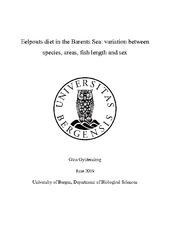Eelpouts diet in the Barents Sea: variation between species, areas, fish length and sex
Master thesis
Permanent lenke
https://hdl.handle.net/1956/20362Utgivelsesdato
2019-06-22Metadata
Vis full innførselSamlinger
- Master theses [267]
Sammendrag
he eelpout family is one of the most common fish families in the Barents Sea. Despite the diversity and wide distribution, we have little information about their ecology, feeding preferences and interaction with other fish. In the Barents Sea, regular monitoring of fish diet started in 1960 and was mainly focused on commercially important fish, while the diet and interactions of other fish were studied sporadically. In 2015, a large-scale stomach sampling program called “Year of the stomachs” was carried out. In total, 27.657 stomachs from 67 fish species, including six species of eelpouts, were collected during the joint Norwegian-Russian ecosystem survey (BESS). The study focuses on eelpouts diet in the Barents Sea: variation between species, areas, fish length and sex. This study is based on 280 stomachs of eelpouts and information of fish length and sex supplemented with habitat data, such as geographical position, sediment type and bottom water temperature. The eelpouts had a diet of great variety. Worms, crustaceans and hyperiids were common prey for both the boreal gracile eelpout and the arctic pale eelpout, but they do not overlap geographically. The pale, arctic and longear eelpout overlapped geographically and partly in the diet. Hyperiids formed an important part of the diet of these three arctic species. The pale eelpout was also found to prey on M. norvegica which have not before been observed in the northern Barents Sea. The greater eelpout differed the most from the other eelpouts, and preyed mainly on echinoderms. These results on the eelpout diet in 2015 didn’t show great changes from earlier findings. However, this study presents important information about temporal and spatial distribution of eelpouts and their prey, that was missing in previous studies, and supplement earlier findings with new prey types, and thus gives an important contribution to mapping of the eelpouts’ diet in the Barents Sea. This is a limited, but important data set that gives better insight to eelpout feeding ecology, trophic interactions and diet similarity.
